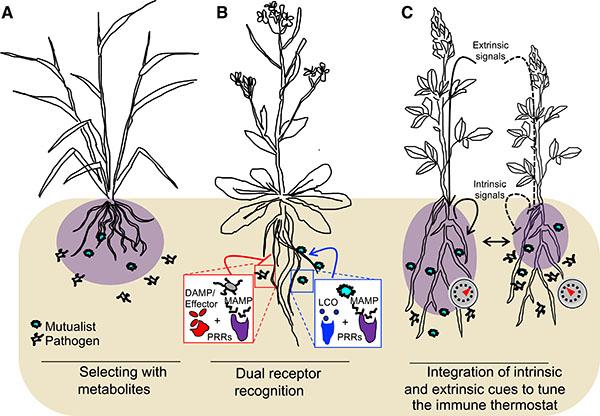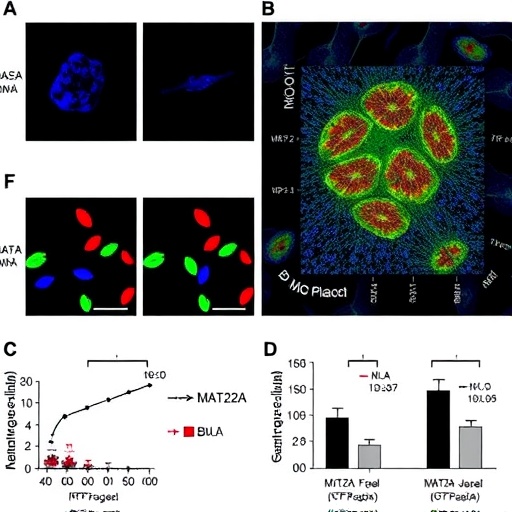Plants are constantly exposed to microbes: pathogens that cause disease, commensals that cause no harm or benefit, and mutualists that promote plant growth or help fend off pathogens. For example, most land plants can form positive relationships with arbuscular mycorrhizal fungi to improve nutrient uptake. How plants fight off pathogens without also killing beneficial microbes or wasting energy on commensal microbes is a largely unanswered question.
In fact, when scientists within the field of Molecular Plant-Microbe Interactions were asked to come up with their Top 10 Unanswered Questions, the #1 question was “How do plants engage with beneficial microorganisms while at the same time restricting pathogens?” Put more simply, how do plants tell good microbes from bad and what do they do about it? As part of a Top10MPMI review series in the open access MPMI Journal, this question of how plants and microbes engage in symbiosis was recently interrogated by Dr. Cara Haney and Dr. David Thoms, microbiologists at the University of British Columbia, in collaboration with Dr. Yan Liang at Zhejiang University in China.
“Maintaining a balance in plant disease resistance where plants can fight off pests and pathogens but still engage with microbes that can help with nutrient uptake is essential for the health of our crops,” emphasizes Haney. To fully engage with such a large question, paradigms are needed to drive specific research questions towards the unanswered pieces. As Haney says, “this question is so broad, I think the review raises more questions than it answers. We attempted to highlight much of what was known, but also what wasn’t known and to provide paradigms and models that could be frameworks going forward.” In a proposed framework for considering mechanisms of symbiotic engagement, Haney, Thoms, and Liang distinguish three principles: chemical selection with metabolites, dual receptor recognition, and tuning of an immune thermostat.
Plants first use metabolite compounds like antimicrobials and chemical signals to recruit beneficial organisms and restrict pathogens, but not all pathogens are excluded. Once plant and microbe are in contact, Thoms proposes that “a dual input model” is used by the plant to distinguish both the type of microbe (bacterial, fungal, or nematode) and the lifestyle (mutualist, commensal, or pathogen). Microbes can be detected by receptor proteins on the surface of plant cells. When receptor proteins detect a piece of fungal cell wall known as chitin, the plant discovers a fungal microbe is present. But as chitin, and other microbe-associated molecular patterns (MAMPS), are often shared among microbes, they are insufficient signals to distinguish commensals from pathogens according to Thoms.
“Unlike most animals, plants do not have an adaptive immune system. However, plant genomes contain many more innate immune receptors than animals,” Liang explains. “Plants also use similar receptors to sense signaling molecules from beneficial microbes, environments, as well as their own cells.” So, additional receptors use a second layer of information to identify pathogens versus mutualists. Symbiosis receptors can identify signaling molecules specifically produced by beneficial microbes, while immune receptors can identify pathogen proteins intended to shut down plant defense. Addressing the need to know both the type and lifestyle of a microbe, Thoms remarks, “I think it’s cool that plants can perceive so many types of MAMPs across different kingdoms of life and I think one use of that is recognizing where the microbe is coming from to give the appropriate physiological response.” Essentially, a plant cell follows a flowchart to determine what reaction is needed in response to the type and lifestyle of microbe it perceives.
Yet, a plant can simultaneously engage with multiple microbes that require different responses, making it more complicated than following the flowchart directly. Energy use for immunity and symbiosis must be balanced based on present microbes and current plant needs. So, the remaining piece of the story is a “normal immune setpoint.” “It is important to understand what this is and how it can be adjusted over a plant’s life in order to maximize yields of our crops,” explain Haney. Because of the impact of the environment and nutrient stress as well, how plants decide to use resources to engage in symbiosis or prevent infection is perhaps one of the biggest areas for exploration.
How to identify and respond to different microbes in variable environments is not a problem unique to plants. “Many living things, ranging from plants to humans, are faced with the challenge of engaging with beneficial microbes while restricting pathogens,” highlights Haney. “As a result, paradigms in plant-microbe interactions may shed light on eukaryotic interactions with microbes in diverse organisms.”
###
Read more in “Maintaining Symbiotic Homeostasis: How Do Plants Engage With Beneficial Microorganisms While at the Same Time Restricting Pathogens?” This article is part of the Top 10 Unanswered Questions invited review series in MPMI. See the list of the top 10 unanswered questions. You can also watch Drs. Cara Haney and David Thoms present on this review article in their free virtual seminar.
Media Contact
Morgan Carter
[email protected]
Related Journal Article
http://dx.





